| Pages:
1
2 |
Bedlasky
International Hazard
    
Posts: 1239
Registered: 15-4-2019
Location: Period 5, group 6
Member Is Offline
Mood: Volatile
|
|
Making rubies using microwave
Hi,
I came across this interesting method of making synthethic rubies.
https://www.youtube.com/watch?v=ybcdRQmQcHQ
|
|
|
elementcollector1
International Hazard
    
Posts: 2684
Registered: 28-12-2011
Location: The Known Universe
Member Is Offline
Mood: Molten
|
|
Realistically, this is more of a 'ruby powder' or 'ruby bead' synthesis, given his setup, but there's no shame in that, and he definitely achieved
ruby!
That said, I have to wonder how this would go if he could keep it molten for longer - with a silicon carbide block, maybe, or some other decent
microwave receptor. Might at least get a ruby 'glass'.
I'm currently building a DIY at-home Czochralski furnace that reaches 2000 C to grow my own sapphires - it's complicated, but not out of reach for the
ordinary chemist if they're willing to put in the work and understand the concepts.
[Edited on 11/7/2021 by elementcollector1]
Elements Collected:52/87
Latest Acquired: Cl
Next in Line: Nd
|
|
|
Triflic Acid
Hazard to Others
  
Posts: 486
Registered: 27-9-2020
Member Is Offline
Mood: Slowly Oxidizing into Oblivion
|
|
Speaking about rubies, I've put in the last few weeks of work towards making a perfectly clear arc-melted ruby. What I've ended up doing is mixing
potassium dichromate into the aluminum oxide and then arcing it. This reacts with the carbon produced and gives a transparent gem. I think that the
potassium ions are screwing up my results, so CrO3 would be ideal. Does anyone have any tips on producing it from K2Cr2O7, preferably without
destroying my dwindling stock of sulfuric acid. I have about ~500mL left and don't want to go distilling just yet.
There wasn't a fire, we just had an uncontrolled rapid oxidation event at the power plant.
|
|
|
woelen
Super Administrator
        
Posts: 8012
Registered: 20-8-2005
Location: Netherlands
Member Is Offline
Mood: interested
|
|
Why use CrO3? Can't you make rubies with Cr2O3, which is much easier to obtain and also is much safer to use? At those very high temperatures, the
CrO3 loses oxygen anyway and it does not oxidize anything, when it is mixed with Al2O3.
If you really want to use CrO3, you can buy that at a good price, both at Onyxmet and at Chemcraft. If you are in the EU, then I think that the net
price, including shipping, will be comparable from both suppliers. If you are outside the EU, Chemcraft probably will be a little cheaper. I have
purchased the chemical from both suppliers. Chemcraft's is a fine-grained solid, which most likely is easier to mix, but Onyxmet's is less humid, the
latter is a perfectly dry sample of fairly large scales.
|
|
|
MadHatter
International Hazard
    
Posts: 1339
Registered: 9-7-2004
Location: Maine
Member Is Offline
Mood: Enjoying retirement
|
|
Ruby
Woelen, I'm with you on Cr2O3. I buy mine from a pottery shop.
BTW, if you want sapphire most likely you'll need titanium.
Triflic Acid, can you get or make ammonium dichromate ?
This is quite flammable and produces Cr2O3 as the only solid.
From opening of NCIS New Orleans - It goes a BOOM ! BOOM ! BOOM ! MUHAHAHAHAHAHAHA !
|
|
|
metalresearcher
National Hazard
   
Posts: 758
Registered: 7-9-2010
Member Is Offline
Mood: Reactive
|
|
I have tried it by mixing Al2O3 with 1-2% green Cr2O3 heating by a welder wit carbon electrodes and indeed a few small pinkish ruby beads appeared.
Using a blackled lamp, they fluoresce nicely.
| Quote: | | I'm currently building a DIY at-home Czochralski furnace that reaches 2000 C to grow my own sapphires - it's complicated, but not out of reach for the
ordinary chemist if they're willing to put in the work and understand the concepts. |
elementcollector1: Making a Czochralski furnace ? That should be a tedious task, you need a very pure crucible and a strictly controlled device to
pull the crystals slowly from the liquid. And how do you heat the furnace ? A temp of 2000+ C can only be obtained by special heating elements, even
the 1700 C Kanthal Super don't suffice. And burning H2 or propane in oxygen costs a lot of high pressure O2 cylinders.
A (n abandoned) medical zeolite based O2 generator generated not sufficient O2.
|
|
|
Admagistr
Hazard to Others
  
Posts: 363
Registered: 4-11-2021
Location: Central Europe
Member Is Offline
Mood: The dreaming alchemist
|
|
I tried to make rubies in the microwave, of aluminium wool, according to the YouTube instructions, but I failed, occasionally a microscopic ruby
arose, but it was no success...That's why I invented my own method. I used a loop of aluminum wire, of high purity, diameter d = 1mm. Direct the first
experiment ended in success... I'm sending some photos from the experiment...Adam
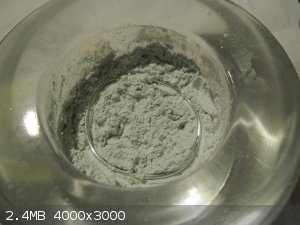 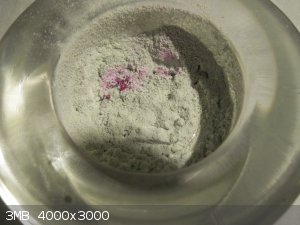
|
|
|
Admagistr
Hazard to Others
  
Posts: 363
Registered: 4-11-2021
Location: Central Europe
Member Is Offline
Mood: The dreaming alchemist
|
|
I have to add that I placed the Al wire in question on a powder mixture of Al2O3+Cr2O3. Composed of 98% Al2O3 and 2% Cr2O3. I'm sending a few more
pictures that didn't fit in the previous posts. There's one ruby drop at the end of the overcooked Al wire !Unfortunately, though, I had to stop the reaction after more than 20 seconds because something started burning in the
microwave oven and it smelled very bad... !Unfortunately, though, I had to stop the reaction after more than 20 seconds because something started burning in the
microwave oven and it smelled very bad...
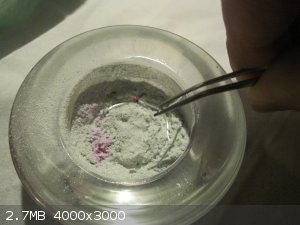 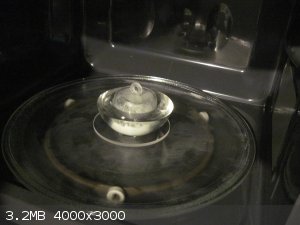
|
|
|
Admagistr
Hazard to Others
  
Posts: 363
Registered: 4-11-2021
Location: Central Europe
Member Is Offline
Mood: The dreaming alchemist
|
|
Quote: Originally posted by elementcollector1  | Realistically, this is more of a 'ruby powder' or 'ruby bead' synthesis, given his setup, but there's no shame in that, and he definitely achieved
ruby!
That said, I have to wonder how this would go if he could keep it molten for longer - with a silicon carbide block, maybe, or some other decent
microwave receptor. Might at least get a ruby 'glass'.
I'm currently building a DIY at-home Czochralski furnace that reaches 2000 C to grow my own sapphires - it's complicated, but not out of reach for the
ordinary chemist if they're willing to put in the work and understand the concepts.
[Edited on 11/7/2021 by elementcollector1] |
Hi, do you have a video or a link to information about your homemade Czochralski oven!? With more enthusiasts involved in the construction, we can
help each other and share our experiences! Thanks, Adam.
|
|
|
Admagistr
Hazard to Others
  
Posts: 363
Registered: 4-11-2021
Location: Central Europe
Member Is Offline
Mood: The dreaming alchemist
|
|
Rubies and unusual thermite mixture...
I'm sending a video I made about a year ago, capturing my idea and my efforts to create a ruby melt from Al2(MoO4)3+Cr2O3+Al, in a chamotte crucible.
The ruby melt was indeed formed, even sprayed into the surrounding area in response, but it is heavily contaminated with molybdenum, which has not
melted and separate from it, unfortunately. I have it confirmed by X-ray analysis. I mean, a lot of MoO3 was squeezing out, as you can see in the
video...I recommend you watch the video in full size;-).But I really enjoyed the pyrotechnic effect...
I posted the video on a profile of a friend of mine who's an astrophysicist. His name is Stanislav Hledík. It was back when I didn't have my own
YouTube account. The video is still unofficial, in a working version, and will only be translated into English later. But there are important
equations in his description, describing the reaction that everyone here at the forum understands;-)...Note how long the mixture burns and stays
hot...I invented this mixture myself:-)
https://www.youtube.com/…SRg
|
|
|
Admagistr
Hazard to Others
  
Posts: 363
Registered: 4-11-2021
Location: Central Europe
Member Is Offline
Mood: The dreaming alchemist
|
|
https://youtu.be/lEosDA7nSRg
|
|
|
Triflic Acid
Hazard to Others
  
Posts: 486
Registered: 27-9-2020
Member Is Offline
Mood: Slowly Oxidizing into Oblivion
|
|
Well, my issue is that the large rubies tend to be really cloudy for me. I want some nice clear gems for my collection. The K2Cr2O7 somewhat solved
the problem, since it got decently less cloudy after adding it. I agree that most of it is likely losing oxygen and becoming worthless, but some of it
does seem to be helping the issue. I'm not sure if this was unclear in my original post, but I'm adding a small amount of dichromate to the Cr2O3, not
using just dichromate.
There wasn't a fire, we just had an uncontrolled rapid oxidation event at the power plant.
|
|
|
Admagistr
Hazard to Others
  
Posts: 363
Registered: 4-11-2021
Location: Central Europe
Member Is Offline
Mood: The dreaming alchemist
|
|
Quote: Originally posted by Triflic Acid  | | Well, my issue is that the large rubies tend to be really cloudy for me. I want some nice clear gems for my collection. The K2Cr2O7 somewhat solved
the problem, since it got decently less cloudy after adding it. I agree that most of it is likely losing oxygen and becoming worthless, but some of it
does seem to be helping the issue. I'm not sure if this was unclear in my original post, but I'm adding a small amount of dichromate to the Cr2O3, not
using just dichromate. |
There is no need to use Cr2O3 for rubies in synthesis at all. I am sending proof, with this photograph, that the rubies were made in a crucible of
technical corundum, purity 96%, using only K2Cr2O7! The mixture in the crucible was melted at 1000 C with a mixture composition of
Li2CO3+Al2O3+K2Cr2O7+MoO3 for approximately 7 hours.
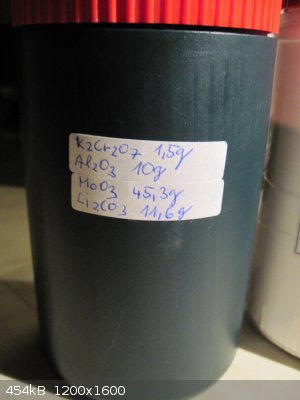 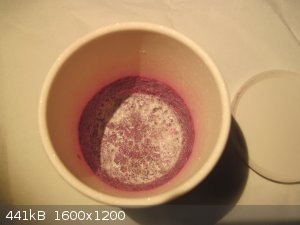
|
|
|
DraconicAcid
International Hazard
    
Posts: 4332
Registered: 1-2-2013
Location: The tiniest college campus ever....
Member Is Offline
Mood: Semi-victorious.
|
|
Nice!
The synthesis of rubies has been on my mind since 1989. I may have to actually try it some day.
Please remember: "Filtrate" is not a verb.
Write up your lab reports the way your instructor wants them, not the way your ex-instructor wants them.
|
|
|
Admagistr
Hazard to Others
  
Posts: 363
Registered: 4-11-2021
Location: Central Europe
Member Is Offline
Mood: The dreaming alchemist
|
|
Thanks for the compliment. Make sure you try and let me know how it goes, you might have more success than me;-). I am sending photos, from a similar
experiment, but without Li2CO3 and K2Cr2O7. I only had a tiny platinum bowl that couldn't even fit a whole mixture of Al2O3+MoO3+Cr2O3, so I only
filled it in part. I heated it at 1000 C for about six hours, in a crucible furnace lined with chammote. I used a CaO to capture the MoO3 vapor. MoO3
also works on beryls-emeralds, chrysoberyls, zircons, hafnons, bromellites synthesis and some spinels that do not contain Mg;-)! Adam
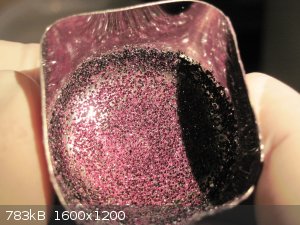 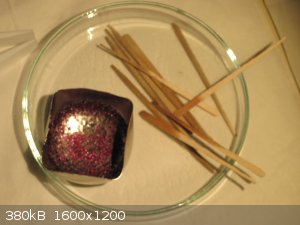
Edit(woelen): removed email address
[Edited on 11-11-21 by woelen]
|
|
|
Triflic Acid
Hazard to Others
  
Posts: 486
Registered: 27-9-2020
Member Is Offline
Mood: Slowly Oxidizing into Oblivion
|
|
You could likely have some success with a tantalum or tungsten crucible, if you could get your hands on one
There wasn't a fire, we just had an uncontrolled rapid oxidation event at the power plant.
|
|
|
Admagistr
Hazard to Others
  
Posts: 363
Registered: 4-11-2021
Location: Central Europe
Member Is Offline
Mood: The dreaming alchemist
|
|
Thanks for the advice. Tantalum might be used to go, but it would corrode...Tungsten would corrode even more. In fact, MoO3 is very corrosive to
metals at high temperatures because it dissolves the protective layer of oxide on their surface:-(Metals seem to be the best material in platinum, but
unfortunately it's terribly expensive. I thought of trying the CaWO4 crucible, but where to get it, or how to make it? Maybe that's a great idea, what
do you think;-)?
|
|
|
Admagistr
Hazard to Others
  
Posts: 363
Registered: 4-11-2021
Location: Central Europe
Member Is Offline
Mood: The dreaming alchemist
|
|
Competition.
It occurred to me that the Supermoderators might run a competition for the prettiest photo/video of an amateur gem and the most original method. If
there was a sponsor, some professional gem-maker, like Mr. Chatham, Mr. Oishi, ladies Osmer and Chase...The main prize could be Chatham emerald,
Ramaura ruby, Alexandrite, bromellite, or chyrzoberyl, which contains gallium instead of aluminum;-) and crystallizes in a hexagonal system...The
condition would be to publish the procedure and teach it to other enthusiasts on the forum;-)! It would be an incentive for others to publish their
results and photos/videos;-). The competition could last one year....
|
|
|
unionised
International Hazard
    
Posts: 5126
Registered: 1-11-2003
Location: UK
Member Is Offline
Mood: No Mood
|
|
|
|
|
Admagistr
Hazard to Others
  
Posts: 363
Registered: 4-11-2021
Location: Central Europe
Member Is Offline
Mood: The dreaming alchemist
|
|
Quote: Originally posted by unionised  |
Thank you for the warning. I'm not doing it anymore. Fortunately, this email address is not my main one, it is my second address and I only use it for
similar cases...I am new to the forum, should I ask the moderator to remove it if possible? |
|
|
|
woelen
Super Administrator
        
Posts: 8012
Registered: 20-8-2005
Location: Netherlands
Member Is Offline
Mood: interested
|
|
I removed the email address. People can contact
you through U2U.
|
|
|
Admagistr
Hazard to Others
  
Posts: 363
Registered: 4-11-2021
Location: Central Europe
Member Is Offline
Mood: The dreaming alchemist
|
|
I found this Japanese tutorial on the internet that I wanted to try. I translated it with a translator, but the added image didn't work for translate.
Is there anyone here who speaks Japanese who would be willing to translate these instructions into English, please? Anyway, I gave it a try, bought 5
pencils of 9B hardness, which corresponds to natural graphite, and set the pencils on fire and let them burn. I obtained small graphite rod this way
simply with point at the end. I took a glass cube for candle with a bowl in the middle and add Al2O3 mixed with 2% Cr2O3 into the depression. Then I
stick into the mixture a piece of graphite rod, a few centimeters long, with the tip up, protruding about a centimeter above the mixture, placed it in
the microwave and turned it on - nothing happened. Then I stick into the mixture second piece of graphite rod with the tip down near the first
graphite rod, when I turned on the oven there was a blinding white glow and melting of the glass after a short time, eventually the glass exploded and
the Al2O3+Cr2O3 mixture splattered all over the microwave owen. After the reaction was complete, one fused glass shard was covered with a few
microscopic ruby crystals that fused into the glass. The next day I changed the experiment a bit, using a crucible from sintered corundum and stick 2
graphite rods close together in the oxide mixture, tips down. Under the corundum crucible I placed a disk of quartz glass which stood on a rotating
glass plate. When I used only one of the graphite rod, again nothing happened and no plasma was produced. It just heated up the crucible a bit, with
the oxide mixture. The reaction took a terrible course, dazzling plasma plumes appeared, white, purple and blue in colour, which repeatedly exploded,
I thought the crucible had been shattered and nothing was left of it. When I opened the microwave owen, to my surprise, I found the cup was perfectly
fine. A small amount of oxides had been scattered around the microwave, but it looked like nothing had happened and no rubies had formed. To find out
what was wrong, I used a spoon to gradually remove the material from the crucible... Almost at the bottom of the crucible, something squeaked and I
pulled out an opaque and irregular ruby pearl over 0.5 centimeters in size! The bottom of the crucible was blackened under the graphite tips. I will
send photos later.
http://limejuice.jugem.jp/?eid=269
[Edited on 27-1-2022 by Admagistr]
|
|
|
oberkarteufel
Harmless

Posts: 47
Registered: 11-12-2018
Member Is Offline
Mood: Mayonesium sulfate
|
|
Hi! Could you please elaborate on this? Was the CaO just put in a dish next to the crucible, or was the setup more complicated?
Also - could the molybdenum crucible be a good, cheaper ersatz for the platinum one?
Because, I dunno, maybe it gets eaten by the MoO3 melt, or is oxidixed at 1100*C too quickly and would require an inert atmosphere... Just asking the
ones with more experience, need to check if this idea holds water.
I also have a question regarding the microwave synthesis.
In this link https://www.youtube.com/watch?v=ybcdRQmQcHQ&ab_channel=N... the guy has no success with a SiC kiln for glass melting. Could it be possible to
combine the ignition by aluminium fiber with the SiC kiln to maintain higher temperature and provide slower cooling/better conditions for the melt to
crystallize? Honestly, I'm not sure if microwaves would even be able to penetrate inside the through the carbide layer.
Zdravím mého jižního souseda.
|
|
|
Admagistr
Hazard to Others
  
Posts: 363
Registered: 4-11-2021
Location: Central Europe
Member Is Offline
Mood: The dreaming alchemist
|
|
Quote: Originally posted by oberkarteufel  |
Hi! Could you please elaborate on this? Was the CaO just put in a dish next to the crucible, or was the setup more complicated?
Also - could the molybdenum crucible be a good, cheaper ersatz for the platinum one?
Because, I dunno, maybe it gets eaten by the MoO3 melt, or is oxidixed at 1100*C too quickly and would require an inert atmosphere... Just asking the
ones with more experience, need to check if this idea holds water.
I also have a question regarding the microwave synthesis.
In this link https://www.youtube.com/watch?v=ybcdRQmQcHQ&ab_channel=N... the guy has no success with a SiC kiln for glass melting. Could it be possible to
combine the ignition by aluminium fiber with the SiC kiln to maintain higher temperature and provide slower cooling/better conditions for the melt to
crystallize? Honestly, I'm not sure if microwaves would even be able to penetrate inside the through the carbide layer.
Zdravím mého jižního souseda. |
Hi! The CaO was in a chamote bowl, which was standing on a chamote bowl, which contained a platinum crucible with reaction mixture.The first chamote
bowl was covered by this second bowl.The two bowls were identical.I found, however, that contact of the chamote with platinum is not ideal, there is a
little corrosion of platinum.It caused by SiO2 at high temperature, in contact with platinum.It is stated that it is necessary to use corundum
ceramics, which does not have this defect.
The molybdenum crucible can only be used in the presence of argon, or in a vacuum, but MoO3 itself acts quite oxidatively and would certainly
react-reduce MoO3 to lower molybdenum oxide.So much better would be a tantalum crucible, as a cheaper substitute for platinum, but it would also be
corrosive, perhaps it would be worth using a large tantalum crucible, or a sealed pipe, for one or two uses.In this way we could eventually create
really big and maybe even nice rubies!Ta2O5, which would be produced here could also act as a mineralizer for the synthesis of ruby crystals .It would like to try, but tantalum is not very cheap either. .It would like to try, but tantalum is not very cheap either.
Your idea of microwave synthesis is interesting and it would like to try it, but you are right that SiC would absorb most, maybe all microwaves and
aluminum would not get these microwaves, but it is just a theoretical assumption, it needs to be tested experimentally...I still want to go back to
the aluminum wool, unlike the aluminum wire, I had almost no success with it, there was mostly no plasma generation.Moreover, it is not made of pure
aluminum, but it is made of technical aluminum alloys, these other metals contaminate the resulting rubies and reduce their quality.But I probably
used wool of inappropriate thickness.
Greetings to my northern neighbor.
|
|
|
Admagistr
Hazard to Others
  
Posts: 363
Registered: 4-11-2021
Location: Central Europe
Member Is Offline
Mood: The dreaming alchemist
|
|
I found this Japanese video with instructions on how to make really big rubies in the microwave!With the help of a burning charcoal, if Parakeet will
be so kind, he will explain to us exactly how to do it...
https://www.youtube.com/watch?v=7KAytAsJHSY
|
|
|
| Pages:
1
2 |